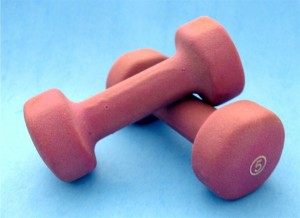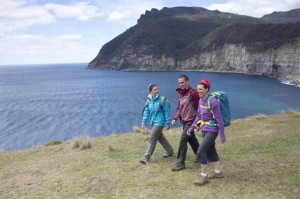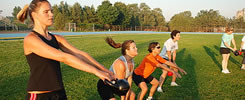Walking with hand weights. Is it a great full body toner, or a waste of time?
You’ll often see people walking or running with small hand weights or even ankle weights. Are these people really making the most of their exercise time?
Weight bearing exercise is crucial for everyone to help build strong bones & muscles as well as provide daily cardiovascular exercise. If only everyone walked more Australia would save billions each year on health expenditure.
Walking or even running burns energy and can be an efficient weight loss exercise. So naturally increasing the weight (by 2-6kg), will increase the effort required & the energy burnt. Right? Technically, yes, while a 75kg person will burn approx. 690kJ in 30mins an 81kg person will approx 745kJ at the same speed.  Unfortunately though using dumbbells are not a sensible option. Carrying weights at the distal (far end) of your limbs such as the hands increases the stress placed on the shoulder & elbow joints in the upper body while ankle weights similarly inappropriately load the hip, knee & many joints of the foot ankle. While walking with weights theoretically increases the exercise intensity practically it doesn’t translate, and poses several injury risks. Any weights that are heavy enough to make a significant increase, place huge stress on joints often developing into shoulder injuries for dumbbell walkers. Conversely weights that are light enough not to place this unsafe stress on joints is barely noticeable to the overall intensity of the exercise.
Unfortunately though using dumbbells are not a sensible option. Carrying weights at the distal (far end) of your limbs such as the hands increases the stress placed on the shoulder & elbow joints in the upper body while ankle weights similarly inappropriately load the hip, knee & many joints of the foot ankle. While walking with weights theoretically increases the exercise intensity practically it doesn’t translate, and poses several injury risks. Any weights that are heavy enough to make a significant increase, place huge stress on joints often developing into shoulder injuries for dumbbell walkers. Conversely weights that are light enough not to place this unsafe stress on joints is barely noticeable to the overall intensity of the exercise.
Compounding this the muscles of the upper body responsible for supporting the extra weight quickly become fatigued as they are held in a lengthened position for the duration of the 30min walk. Most of our muscles are designed to generate movement no hold weights by your side as you burn up the footpath. Those people walking along pumping the weights above their head are on the right track (well, sort of).
The best alternative is to pick heavier weights you’re not going to walk with, put the weights down in a central spot and walk a loop that regularly passes by the weights. Break up your walk with a series of strength exercises & then get back to your walk. This will allow you to lift more, recover while you walk, & allow your to come back for another set. A win-win
Even a relatively easy 15min strength session will burn in excess of 300kJ which when combined with your walk will prove a great combination workout for beginners & the less active.
For the best way to increase fitness gains from walking alone read our blog on walking for health which outlines how increasing the intensity can increase the fitness benefits.
Training to walk in heavy gear (such as for a snow expedition) or with a heavy pack may require the need to load up however.
Adding weight to increase intensity
The safest way to add weight to increase the challenge is to keep the weight central to your body. Moving it from the distal part of the body (ankles & hands) and bringing it proximally to the torso will reduce the injury risk. Backpacks and weight vests offer good alternatives and varying levels. For people training for a trek or walking holiday it’s important to get used to carrying an increased load of the pack, but progress gradually. Start with a 5kg and keep the load close to the body as possible. 2 litres of fluids in a bladder and some clothing can be packed to form a tight 5kg bundle to begin with. As you increase the load make sure you use the hip belt features on trekking packs and distribute the weight so it is primarily on your hips & less on the shoulder straps. Poorly packed backpacks with uneven loads or ill-fitting bags increase the risk of back & hip injuries.
Weight vests are a good alternative, which keep the weight at the torso but again progress slowly. The increased weight will increase the impact forces you experience with every step so progress gradually as you become stronger. 
The best alternative is to pick heavier weights you’re not going to walk with, put the weights down in a central spot and walk a loop that regularly passes by the weights. Break up your walk with a series of strength exercises & then get back to your walk.
For more strategies to get the most from your walking or for tips on how to progress to more advanced session contact us.
Enjoy your training!



Speak Your Mind